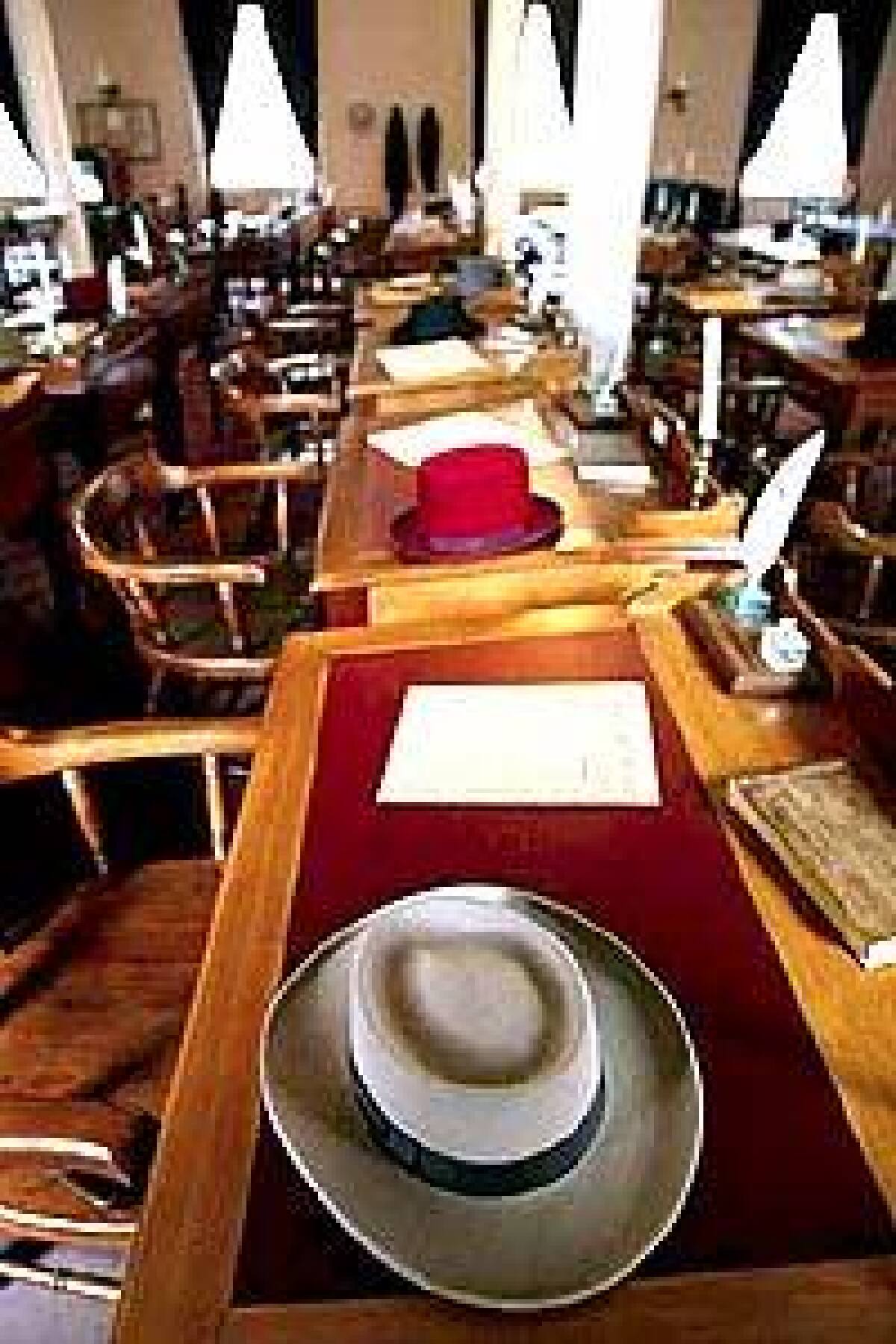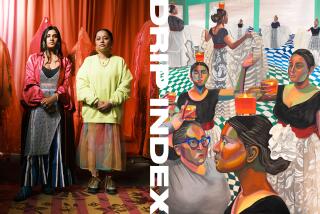Benicia artfully tips its hat to the past

Benicia, Calif. — My friend Karen, an antiques fan like me, pointed to a set of eight aluminum tumblers. “Hey, remember those?”
Ooh! The best, just like my mom’s. This antiques store, the first one we popped into on Benicia’s main street, held promise.
We found Barbie in her original striped bandeau bathing suit, pearl earrings and high heels. Miniature muffin pans. Painted china like my adopted grandmother made. But what was this on the wall behind the cash register at the Benicia Antique Shop? A thoroughly modern Oakland Raiders banner?
“My wife had me bring the TV here to watch the games so she has some peace at home,” the proprietor said.
Smart woman, we thought. Televised football was a big reason we escaped from the guys at home for a girly weekend last month in historic Benicia, a city of 28,000 about 35 miles northeast of San Francisco.
Benicia, named for the wife of Gen. Mariano Vallejo, the landowner who ceded the property on which the city was built, grew up as a manufacturing center on the Carquinez Strait. Since its founding in 1850, it has been home to tanneries, potteries, packinghouses, a federal arsenal and, briefly, the state Capitol and author Jack London. These days, the studios of more than 100 painters, printmakers, photographers, jewelry designers, sculptors and glassblowers complement Benicia’s colorful past.
Urged on by a sunny Saturday morning, Karen and I strolled down 1st Street, the main street, aahing at the false-front Western-style buildings -- some dating from the mid-1800s -- that lead to the waterfront. It seemed as if all of Benicia’s dogs were walking their owners, who nodded and said “Good morning” as we passed.
A train whistle cried far away; a freight train rounded the base of a hill across the strait. An oil refinery in Martinez puffed smoke against the backdrop of cloud-cloaked Mt. Diablo. Sculls and kayaks ruffled the water, which rolls west from the Sacramento-San Joaquin Delta to San Pablo Bay and Marin County. The muddy current swirled around the pilings of Benicia’s T-shaped fishing pier, where a man and a boy waited patiently for a bite. At the base of the pier, a dad fashioned for his daughter a boat made of weeds and graced with a Queen-Anne’s-lace sail.
Fifteen-year-old Jack London arrived at this waterfront in 1891 after a short career as an oyster pirate on San Francisco Bay. Here he was a member of the Fish Patrol, which prowled for maritime wrongdoers and provided material for his stories “Tales of the Fish Patrol” and “John Barleycorn.” London stayed about a year before returning to his parents’ home in Oakland. But his name remains on a Benicia park, restaurant menus, historic markers.
Hand-blown beauty
Karen and I ducked into antiques and gift shops as we walked back up 1st Street. A sign at F Street encouraged visitors to drop in on glassblowers a half-block away at Lindsay Art Glass.
Owner David Lindsay and a helper worked at the shaping oven, sticking the glass-dipped ends of metal rods into an orange-hot chamber until the glass became pliable enough to roll and blow into globes. The artists gently tapped each decorative bauble to separate it from its rod, then softened clear glass to make a hanging loop.
More glassblowers and artists cluster near the old arsenal near the east end of town. Nourot Glass Studio, Smyers Glass and Zellique Art Glass occupy one large building on East H Street. Sunlight danced through the deep blue and brilliant red vases, bowls and plates visible through the showroom window. We walked into a wonderland of metallic lusters, pastels, multicolor swirls and layers of color, and matte and shiny surfaces. The glassblowers had finished for the day, but their craft remained, ranging from platters as big as my kitchen table to mouth-blown morsels of glass captured in wire for a necklace.
The candy colors of the glass reminded us of lunch. We chose the Camellia Tea Room on 1st Street. Women packed every small table in the room, a decidedly feminine mauve, plum and gold setting with an elegantly gilded pressed tin ceiling.
We watched thick sandwiches and big salads pass our table, but, sticking with the notion of afternoon tea, we split one savory tea plate and one sweet plate, plus two fragrant teas among dozens of choices.
One thing about afternoon tea: It’s no Hungry Man meal. The savory plate offered three dainty finger sandwiches and a tiny mound of rice-currant salad. The sweet plate held a miniature custard tart, a finger-length wedge of gingerbread and a nugget of walnut-cinnamon cookie.
Feeling lightly fortified, we walked to Benicia Capitol State Historic Park. In 1853 and ‘54, before moving to Sacramento, the state Legislature met in this two-story building designed as the new city hall. Here lawmakers put their quill pens to bills establishing the first state prison, at San Quentin, and granting women the right to own property in their own names.
Thinking of those dark chambers with only one wood stove per floor, we retreated to the Inn at Benicia Bay, an 1850s Victorian home renovated as a nine-room B&B. Resident cat Molly McGee bounded to us as we walked past the white picket fence and toward the $159-a-night Jack London Room.
London would have enjoyed the vintage Waterfall-style armoire and chifforobe, the rattan headboards and tapestry bedspreads, the bombé table painted with landscapes, the spa bathtub. He would have enjoyed this room right down to the view of the brick garden patio outside the French doors.
Chatty birds darted through the garden, picking up supper. Karen and I walked around the corner to the First Street Cafe for our own spicy dinner, starting with an appetizer of hefty crab cakes made from the local catch. Karen’s chicken jambalaya came packed with tender morsels of meat. I could barely drop the fork from my apricot-and-cilantro chicken long enough to keep up my end of the conversation.
Molly the cat greeted us for breakfast too. We felt pampered as inn owner Mike Lamb poured our coffee, but we couldn’t wait until he left so we could dive unobserved into granola, yogurt, fresh fruit and pastry.
We saved room for the day’s destination: the Jelly Belly factory tour in Fairfield, less than 20 miles north. The candy company gives its bean makers weekends off, but that doesn’t halt tours.
From the high catwalks, we looked down at the factory in awe and watched a videotape of weekday action as our guide described how beans take shape in enormous copper kettles and washing-machine-like polishers. The best surprise: the Jelly Belly art gallery, a collection of celebrity portraits built entirely of beans. Karen and I wondered if Pope John Paul II knows how good he looks in the piña colada and peanut butter flavors.
We couldn’t leave Solano County without saying goodbye to Benicia. Loaded with 10 pounds of Belly Flops -- irregular Jelly Belly beans from the factory store -- for the fellas back home, we made one more trip to the waterfront, one more promise to remember Benicia at least as fondly as Jack London did.
Holly Ocasio Rizzo is a journalism instructor at Cal State Fullerton and a freelance writer based in Orange County.
More to Read
Sign up for The Wild
We’ll help you find the best places to hike, bike and run, as well as the perfect silent spots for meditation and yoga.
You may occasionally receive promotional content from the Los Angeles Times.






